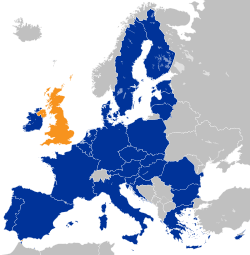Accession of the United Kingdom to the European Communities
The Accession of the United Kingdom to the European Communities (EC) – the collective term for the European Coal and Steel Community (ECSC), the European Economic Community (EEC) and the European Atomic Energy Community (EAEC) – took effect on 1 January 1973. This followed ratification of the Accession treaty which was signed in Brussels on 22 January 1972 by the Conservative prime minister Edward Heath, who had pursued the UK's application to the EEC since the late 1950s. Denmark and Ireland also joined as part of the same expansion but Norway, who had signed the treaty, declined to ratify it and so it was amended to exclude that country.[1] The ECSC and EEC would later be integrated into the European Union under the Maastricht and (subsequently) Lisbon treaties.
The UK was the first country to establish a Delegation to the ECSC in 1952 and the first country to sign an Association Agreement with the Community in 1954.
The UK had first applied to join in 1961, but this was vetoed by French President Charles de Gaulle.
After de Gaulle had relinquished the French presidency in 1969, the UK made a third and successful application for membership. The question of sovereignty was discussed at the time in an official Foreign and Commonwealth Office document. It listed among "Areas of policy in which parliamentary freedom to legislate will be affected by entry into the European Communities": Customs duties, Agriculture, Free movement of labour, services and capital, Transport, and Social Security for migrant workers. The document concluded (paragraph 26) that it was advisable to put the considerations of influence and power before those of formal sovereignty.[2] The UK's negotiation team in 1970–72 included Con O'Neill and David Hannay.[3]
The Treaty of Accession was signed in January 1972 by prime minister Edward Heath, leader of the Conservative Party.[4] Parliament's European Communities Act 1972 was enacted on 17 October, and the UK's instrument of ratification was deposited the next day (18 October),[5] letting the United Kingdom's membership of the EC come into effect on 1 January 1973.[6]
Origin
Shortly after the creation of the ECSC in 1952, the UK became the first country to establish a Delegation in Luxembourg, the seat of the High Authority (present-day European Commission) at the time. On 24 December 1953 the High Authority invited the British Government to enter into negotiations for the establishment of an association. On 29 April 1954 the British Government invited the High Authority to London to begin discussions on the proposed association and on 21 December 1954 the Agreement of Association was signed in London entering into force on 23 September 1955. This was the first example of an EU Association Agreement.[7]
The Agreement of Association established a Standing Council of Association which was intended to provide 'a means for the continuous exchange of information and for consultation in regard to matters of common interest concerning coal and steel' (Article 6). The first meeting took place on 17 November 1955 in Luxembourg. At the second meeting on 22 March 1956 in London, the High Authority and the British Government agreed to open tariff negotiations.[8]
See also
References
- ↑ The European Union Encyclopedia and Directory, Psychology Press, 1999, p. 388, ISBN 9781857430561
- ↑ FCO 30/1048, Legal and constitutional implications of UK entry into EEC (open from 1 January 2002 under the Thirty-year rule).
- ↑ O'Neill, Con; Hannay, David (2000), Britain's Entry Into the European Community, Psychology Press, ISBN 9780714651170, ISSN 1471-2083
- ↑ "Into Europe". Parliament.uk. Retrieved 25 February 2017.
- ↑ "English text of EU Accession Treaty 1972, Cmnd. 7463" (PDF). Retrieved 24 February 2017.
- ↑ "1973: Britain joins the EEC". BBC News. 1 January 1973. Retrieved 9 March 2016.
- ↑ European Yearbook. III. Springer Science+Business Media. 2013. p. 365.
- ↑ European Yearbook. III. Springer Science+Business Media. 2013. p. 369.

